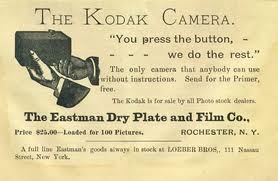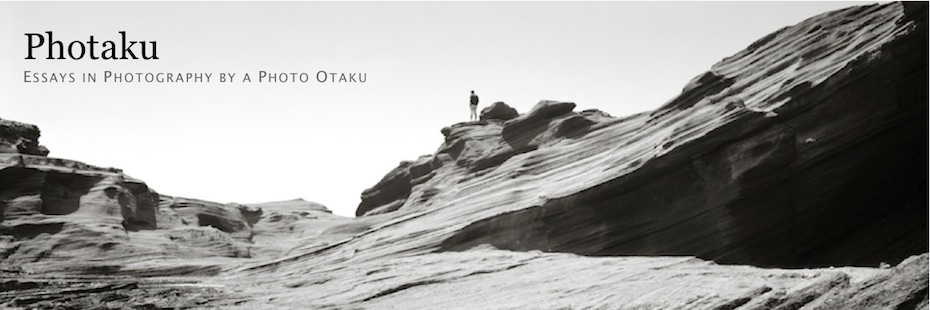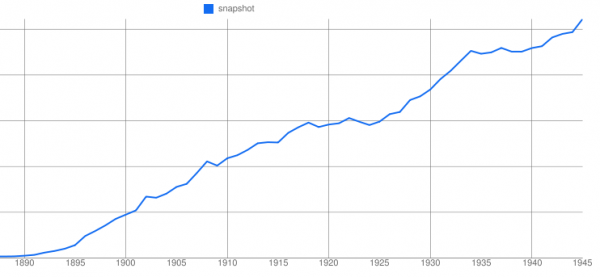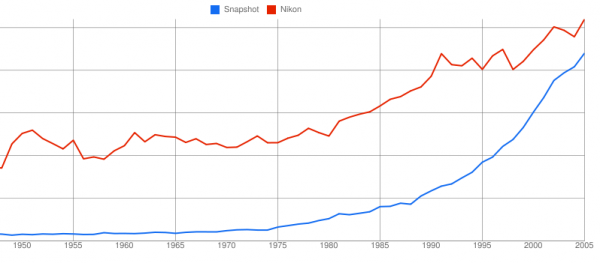The Snapshot
I’m beginning this series of essays with a consideration of the “snapshot” because it places us simultaneously in the present and at a crucial turning point in the history of photography over a century ago. It also offers a means to begin an inquiry into the relation among technical, aesthetic, and social aspects of photography, past and present, which is the general interest behind these writings.
While perhaps nowadays accruing a faint aura of the quaint associated with mechanical cameras, the word “snapshot” has nevertheless become practically synonymous with the word “photograph” among the general population because it was through the so-called snapshot that the general population came to know and practice photography directly. Professional studio photographers and the serious artistic amateurs of the last half of the nineteenth century—with their large view cameras loaded with plates (wet and dry) of slow emulsions and mounted on tripods for what by today’s standards would be considered relatively long exposures—took photographs. The common man and woman—with the new late-nineteenth-century inventions of hand cameras and roll film and processing services, thanks largely to George Eastman and his newly founded company, Kodak (1881)—took snapshots. And snapshots occupied a category of photography distinct from and implicitly below the Serious Photograph. They were associated with the casual “shooter,” notably including women who were prominently featured in advertisements for the latest hand-held cameras that hit the markets in the late 1880s and 1890s. Hand cameras, it was grudgingly admitted by Serious Photographers, had their place for those people whose goal was “simply to be able to carry home records of the scenes through which they pass and wish to be burdened as little as possible; for those who are not strong enough to carry a larger camera, with tripod, dark slides, and other paraphernalia, on a day’s tramp without undue fatigue, and for ladies.” (Robert Johnson, Photography, Artistic and Scientific, 1895, p. 85). In other words, at the time of its introduction into the photographic lexicon, “snapshot” was far from synonymous with “photograph.” (And Real Men did not use hand cameras.)
A perusal of popular photography journals suggests that the word “snapshot” gained currency in photography by the 1890s, just after the introduction of the first Kodak hand camera (1888). Google’s Ngram Book Viewer, which graphs the usage of words in print over time, corroborates this time. There is a quick rise in usage from 1890 that continues steadily to WWII:
The trend flattens throughout post-WWII until the mid-1970s from whence it rises steadily again until 2005, suggesting a conjunction between the baby boom generation and mass-marketing of compact, affordable, automatic 35mm (Japanese) cameras (the graph for the word “Nikon” almost perfectly parallels the trend for “snapshot” from 1975):
Originally a hunting term meaning “a quick or hurried shot taken without deliberate aim, esp. one at a rising bird or quickly moving animal” (Oxford English Dictionary), the word “snapshot” implies the opposite of normal photographic practice in the nineteenth century, where taking a photograph typically entailed many minutes to set up and complete. Before the advent of artful street photography, a snapshot was a casual affair and cameras capable of delivering them were intended for the casual Everyman and Everywoman photographer who hadn’t the time or inclination to master to fine points of focus and exposure. And with Eastman Kodak’s new system of preloaded roll film included with the first patented Kodak camera (and later roll film you loaded yourself) and sent to the factory for processing (“You push the button, we do the rest”),  you needn’t bother with the fine points of developing and darkroom work. You were simply a shooter, pulling a trigger. That we now routinely refer to any photograph—snapshot or not —with the same ballistic term “shot” seems also to derive from this original context of “snapshot.” Aim, fire—today’s “point-and-shoot” digital cameras repeat the same metaphor.
you needn’t bother with the fine points of developing and darkroom work. You were simply a shooter, pulling a trigger. That we now routinely refer to any photograph—snapshot or not —with the same ballistic term “shot” seems also to derive from this original context of “snapshot.” Aim, fire—today’s “point-and-shoot” digital cameras repeat the same metaphor.
Different equipment—view cameras on tripods versus hand-held cameras —is not what ultimately distinguished the “proper” photograph from the snapshot. What separated the photographer and the snapshooter (and they were originally quite consciously separated) was a consideration of time on a general and an immediate level. (Money was relatively less a divider because although considerably less expensive than wet or dry plate gear, the first Kodak was for that time expensive at $25.) Generally, only the leisure class, certain scientists (usually of the leisure class), and professional photographers (aspiring to join the leisure class) had the time required to learn the fine points of the art and science of plate photography from start to finish. More immediately, few people outside of the truly dedicated had the endurance and patience required to set up and execute successful exposures on large plate cameras (assuming they could afford a large plate kit). Hand cameras were less expensive and, more importantly, designed to minimize the burden and the active involvement of the operator. As they evolved, Kodak hand cameras represented the logical extreme of this goal with relatively inexpensive, hand-held, fixed-focus, simple shutter cameras that could do many exposures on roll film that Kodak would process for you. Operations that required time were built into the mechanics of the camera and Kodak’s processing system. Assuming adequate lighting, the operator really need only to follow guidelines on framing the subject. In other words, you need only to aim and pull the trigger—to shoot, in a snap.
That the snapshot had everything to do with (split-second) time is evident not only in its linguistic origins and our common associations with it today. Early discussion of the snapshot was always in the context of the newfangled mode of “instantaneous” photography that became possible with the advent of faster lenses and eventually faster emulsions, but that technology lagged relatively behind that of lens design. Once the optical issues of spherical, chromatic, and coma distortions at large (= fast) apertures were gradually overcome with better designs and better glass (an interesting history in and of itself) and emulsions (film) became more sensitive to light (= fast), then one could imagine need for a mechanical shutter of the blisteringly quick speed of … one-tenth of a second, maybe even an unimaginable 1/50 of a second! (modern mechanical shutters routinely reach speeds of 1/250, 1/500, and even 1/1000). The use of such shutters at settings other than “T” (time = open until clicked again) and “B” (bulb = opened by pneumatic bulb and closed when bulb is released) is what was meant by “instantaneous” photography in the nineteenth century and into the twentieth. (I have open before me at this moment a copy of the 1919 user guide to the Kodak 3A Autographic, in which Section II is entitled “Instantaneous Exposures” and subtitled, in quotes, “Snapshots.”) In fact, the earliest printed usage of “snapshot” in a photographic context predates its widespread adoption by thirty years and comes from none other than the venerable Sir John F. W. Herschel in a prescient piece called “Instantaneous Photography” in the The Photographic News (11 May 1860) where he is describing his “dream” of realizing “stereoscopic representation of scenes of action”:
I take for granted nothing more than, 1st, what photography has already realised, or we may be sure it will realise within some very limited lapse of time from the present date—viz., the possibility of taking a photograph, as it were, by a snap-shot—of securing a picture in a tenth of a second of time.
Thirty-five years later, in the chapter “Instantaneous and Snapshot Work” in Photography, Artistic and Scientific (1895) cited above, the authors further relate but distinguish the two:
It is rather difficult to decide what should be classed as instantaneous work. We think, however, that a photograph which has received an exposure of, say 1/50 sec., in order to avoid over exposing the plate, should not be considered as instantaneous work, and we propose only to include in our classification photographs of subjects that require an exposure of 1/25 second or less, because of the rapidity of movement of the subject.
Snapshot work is, of necessity, instantaneous; but we shall consider it separately, since it is of a different character. In what we shall call snapshot work, the camera cannot be fixed upon a tripod, and is used rather to photograph a chance object, used without any preliminary notice.
Herschel’s blistering 1/10 second has shortened to 1/25 or less, and the element of acting without premeditation of the subject has been added. In this view, then, rapidity of movement of the subject coupled with chance moment equals snapshot.
And, in popular discourse during this early period and to some extent today, snapshooter equals something less than the refinement of the Serious Photographer. In some instances, “snapshot” is uttered with barely veiled contempt and conjures associations with uncouth commoners, forerunners of pushy press photographers and paparazzi. Amid the Kodak craze of the 1890s so-called “camera fiends” armed with Kodaks appeared at beaches to steal photos of female bathers, leading one beach resort to ban Kodaks from its beach (I presume large plate cameras were still allowed). The American Journal of Photography (1894), for example, in commenting on First Lady Ruth Cleveland’s public appearances stated that “Whenever she appeared in public a wholesale battery of kodaks were awaiting an opportune moment for a ‘snap shot.’” Or Merwin & Webster in the novel Calumet ‘K’ (1901): “Young men with snap-shot cameras waylaid Bannon.” And O. Henry writing in the August 1903 issue of Everybody’s Magazine: “You see a man doing nothing but loafing around making snapshots.” And finally my favorite, the Daily News on 3 May 1897 where the word is already serving as a metaphor outside of photography: “Your Yankee interviewer is a snap-shot incarnate.” There were indeed denigrating jokes about Serious Photographers and their clunky gear, fetishization of the latest lenses, and strange fixations on darkroom chemistry, but those directed at snapshooters carry a perspective that is undeniably down one’s nose.
However, by the end of the twentieth century, it was the snapshooter who prevailed, socially, economically, and, arguably, aesthetically insofar as mass-consumer cameras designed for quick and easy use set the stage for photojournalism, social documentary photography, real life reportage, “candid cameras,” and street photography full of les moments decisifs. Henri Cartier-Bresson may have used an expensive Leica, hung out at a locale for hours, and (pre)composed thoughtfully through the viewfinder waiting for that decisive moment to arrive (unlike your typical snapshooter), but he descended from the 19th-century common snapshooters, not the landscape and studio portrait photographers. With its emphasis on the instantaneous, the quick, the transitory, the chance event, the sudden phenomenon, the snapshot was modern and its politics were implicitly democratic while its economics was mass-consumer capitalist. It flew in the face of the elitism, luxury, and esotericism associated with Serious Photography of the Big (or even Not-So-Big) Slow Camera, which, ironically, would by the twentieth-first century practically extend to any practitioner of any kind of analog film photography of any size format in an age awash in pixels.
Finally, the idea of the snapshot and the technology that birthed and raised it would come to shape a new photographic aesthetic and expectation of what a (socially) significant photograph should be. Outside of fine art photography of the exhibition gallery that is, I would argue, only a restricted public space, and pornography that is also restricted in its publicness, the most publicly circulated photographic images—those in newsprint and magazines—captured action and moments, hopefully falling into a pleasing composition as it conveyed visual information about the world and/or provoked some intellectual or emotional response from the viewer. These latter attributes could elevate a “mere” snapshot to the ranks of high art, social consciousness, and political engagement (whether or not the snapshooter intended it). In a sense, Cartier-Bresson’s idea of the decisive moment represents the modern refinement of the snapshot—one might say the aesthetic embodiment of a photography largely conditioned by mass-consumer capitalism and modern values of speed and mobility. It, in turn, becomes the model for snapshooters after him even if the casual shooter doesn’t get much beyond the “Kodak (Decisive) Moment.” The Ansel Adams and the Edward Westons of the world, although an endangered species, still hefted their Big Cameras, but they were trying to capture eternity, not moments (see the third essay of this series, “f(ascism)/64” when it is written).
There is, ultimately I think, a kind of tyranny of the moment that the snapshot has encouraged (and Cartier-Bresson has enshrined). What I mean by that is that people tend to take for granted that photography means “capturing the moment” without ever stopping a moment to consider what a moment is and what it means to capture it. We will stop and do just that in the next essay, “The Decisive Moment?”
(originally published 13 June 2011)
2 Responses to The Snapshot
Leave a Reply Cancel reply
Musings & Experiments
- Collodion Bastards and the Indian Connection
- Microtypes
- Figalotypes
- R.B. Graflex Series D Lens Catalog
- The R.B. Graflex Series D Restoration Project
- Worldwide Pinhole Photography Day 2012
- It’s Official: I’m a Large Format Whore
- A New “Book” Project?
- No Longer a Kodak Shareholder
- Kodak Restructures and Brings My Shares Back to Break Even
Latest Flickr Post








Gerald,
I enjoyed this essay, and I am glad I heard you talk about it before you committed the interest to writing. In an interview Charlie Rose had with Henri-Cartier Bresson (accessible online) the issue of thinking came up. Bresson insists he simply tries to be part of the flow of things, that is, he is present, and in fully being present he is able to proscribe thinking (it sounds easy). He says “thinking is dangerous”. So I was surprised to read in your essay that HCB might have patiently sat for hours with his scope on target, having previously envisioned the background-geometry to a millimeter: waiting for a miracle to occur. But he is not just waiting for a deer neither something dear to come. What made him shoot?
Granted, preparation or anticipation have nothing to do with thinking or bringing about the decisive action. And being patient does not mean being intelligent: we can set up a machine just to do that and we’ll never call it intelligent. All the preparation in the world may never lead to the anticipated ideal, or to the right thought; it may simply never come. Something will of course come, but regardless of technique/style/selection, (if you were a fisherman, net) how does the catch come by? Or, why do we settle for one ideal rather than another?
If he had infinite patience (I no longer know if this is a virtue or not), then all we need is a good eye for geometry… sit still, and hope something will happen. But oftentimes nothing happens! Some duchess once said: “fear and hope cloud observation”… For some reason I cannot think of HBC as someone who was hoping for something, not even to be an artist. This is a gut feeling I get from watching his interview with Charlie Rose, where he really gets defensive when Charlie cites R. Avedon, or someone, saying Henri is the “best living photographer in the world”. (The interview was conducted just before HCB died). I’m so intrigued by this idea of sitting and waiting. What does it lead to? Even if you have all the margins set, even if you build a cast around your arm, leaving only the little index to pull the trigger, the instant is so powerful that it may send all your previously determined schema totally out of focus or frame, a force so strong that it would completely shatter that gypsum cast. How do you keep so cool?
Perhaps the answer lies in “F(ascism)-64”!, which I’m looking forward to!
Cheers,
D-
And I enjoyed your response, David. I only brought in the HCB stuff because the impression one gets from his work is that he was running around Paris snapshooting when in fact, while I think he is akin to the snapshooter, he is actually more determinant than your typical snapshooter. I read somewhere (can’t remember where) that he was more patient and deliberate than one might think, that he would scope out a site and wait. How long? Qui sais… ?
The notion of waiting for “it” to happen is interesting. But one doesn’t have to be “sitting and waiting” as you put it. One could be in motion and wait, a kind of active waiting, I suppose. Waiting as such also seems to drag in time again–one waits against the clock. I want to shift things away from time and more toward space so that “waiting” can then be conceived as simply relative motion among objects/people in a spatial field. As relative motion, I could be stationary or moving and in both cases still be in changing positions relative to others whom I may or may not happen upon. The “moment” (let’s call it the framing moment when a shutter might click) then can be conceived of as a conjuncture or overlapping of positions in a spatial field that doesn’t require a set duration to exist as such. But I’m moving too much into the next essay, I’m afraid….